 For all of the scope models on the market, it isn’t all that easy to locate the right product. As an example, last I checked, it’s darker in the woods then in an open field, so why are large light gathering objectives always tied to high magnification scopes designed for long range applications ? The problem is, most scope manufacturers are focusing technological development on the expensive extended range models. If I want a compact scope, I’m going to generally get a product with features that lag new models by a couple of years.
For all of the scope models on the market, it isn’t all that easy to locate the right product. As an example, last I checked, it’s darker in the woods then in an open field, so why are large light gathering objectives always tied to high magnification scopes designed for long range applications ? The problem is, most scope manufacturers are focusing technological development on the expensive extended range models. If I want a compact scope, I’m going to generally get a product with features that lag new models by a couple of years.
Since I was going to start working up some handloads for the new rifle, I thought I might get a higher range variable scope and make the job of accuracy testing a little easier. I also wanted a chance to see if I could get decent performance out of a moderately priced model. I’ve gotten to the point where I don’t want to follow my fellow shooters down the road to economic oblivion, paying more for optics then the rifle I put them on. Eventually the Winchester will be fitted with a compact variable power scope, something as close to 2-6X as I can find, maybe in the 10 – 12 ounce range, but for now…
Manufacturers seem to have locked on to the phrase “When you’re on the hunt of a life time, isn’t extra performance worth a few dollars more ?” Right, and typically on the other side of that statement is: an $80 box of .30-06 ammo, a $500 gun case, a $1,000 range finder, a $5,000 limited production .270, or a $1,500 scope. The truth of the matter is, standard ammo is so good I’ve never seen a misfire or a failed bullet, a freight handler could walk off with a rifle even if it were shipped in a safe, in another year range finders will be $100 items, a $500 Remington or Winchester will shoot just as straight and with the same ballistics as a $5,000 trend piece, and I’m thinking I can do better on value than a Swarovski.
I am not adverse to spending money for something special; the price of unique metal or wood work, artful engraving, truly innovative product, or precision made barrels or actions where performance is reflected in actual accuracy or ballistics. I’m getting tired of the tiny disclaimers at the bottom of ads suggesting “actual performance may vary based on temperature, weather, current exchange rates and, most certainly, the quality of the product”, all statements made with the expressed purpose of releasing the manufacturer from responsibility for any claims they might have made while trying to separate you from your wallet. Most of the high end products in general distribution are just more mass produced manufactured goods selling on a trend name – Isn’t a Lincoln just a Ford with a much bigger price tag.
With cost and features in mind, this was my short list of scopes I examined in detail –
| Brand | Model | Power | A.O. | Field of view Ft.@100 yds |
Eye Relief inches |
Objective Dia. mm |
Weight Ounces |
Length Inches |
Street Price |
| Burris | Black Diamond | 3-12X | Y | 34-12 | 3.5-4.0 | 50 | 25 | 13.8 | $520 |
| Burris | Signature | 3-12X | Y | 34-11 | 3.5-4.0 | 44 | 23 | 13.8 | $429 |
| Bushnell | Elite 3000 | 4-12X | Y | 27-9 | 3.0 | 40 | 15 | 13.2 | $259 |
| Leupold | Vari-X III | 3.5-10X | N | 30-11 | 4.6-3.6 | 40 | 13 | 12.5 | $438 |
| Nikon | Monarch | 4-12X | Y | 25-8 | 3.6-3.4 | 40 | 20 | 14.6 | $360 |
| Simmons | AETEC | 3.8-12 | Y | 33-11 | 4.0 | 44 | 20 | 13.9 | $210 |
| Swarovski | AV | 4-12X | N | 29-10 | 3.5 | 50 | 14 | 13.5 | $1270 |
| Tasco | MAG IV | 3-12X | N | 35-9 | 3.25 | 40 | 12 | 12.2 | $69 |
The effort concluded with the purchase of a 3.8-12X44 Simmons AETEC scope and a set of 2 piece standard Leupold mounts with medium height rings for the short action, pre ’64 design Winchester. The scope came from PrecisionDelta and the mounts and ring set from Brownells. I reviewed the general features of the rifle the last time around, so I thought I’d spend a moment or two on the scope and mounts.
 The AETEC is a relatively inexpensive scope with a lot of power. Simmons promotes the lens system, but doesn’t specify much relating to the inner construction of the scope. You also wouldn’t find tags denoting “Made in USA”. Simmons Optics is a UK based company, but the AETEC is assembled in the Philippines – not a good or bad thing, just an observation. When Nikon optics and cameras began representing the best and most advanced camera technology, people were still paying a premium for obsolete Leica’s because they were made with “German precision”. Process control is more important than geography.
The AETEC is a relatively inexpensive scope with a lot of power. Simmons promotes the lens system, but doesn’t specify much relating to the inner construction of the scope. You also wouldn’t find tags denoting “Made in USA”. Simmons Optics is a UK based company, but the AETEC is assembled in the Philippines – not a good or bad thing, just an observation. When Nikon optics and cameras began representing the best and most advanced camera technology, people were still paying a premium for obsolete Leica’s because they were made with “German precision”. Process control is more important than geography.
If I were going to stick the scope on a rifle with heavy recoil I might be more biased toward a company like Leupold or Burris, both touting the robust mechanical design of their products, but it’s being installed on a .243. But come to think of it, I spent a good number of years hunting with $50 Bushnell and Weaver scopes that got bounced around pretty good and still never failed, and the old Tasco variable scope on my 7mm Mag has the clearest image, and holds the tightest adjustment of any scope I own. In fact, I guess I’ve never had a cheap or expensive scope break, fog, shift focus, or…. Maybe, I’m just lucky.
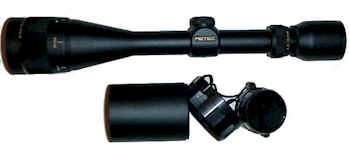 It was nice to open the shipping carton and find lens caps and a sunshade. I have this collection of little gold scope bags and wipe cloths I never use, but up until now, I’ve had to purchase every cap set I own. The lens shade, however, makes the scope enormous and may never see the light of day… even though that’s what it was obviously designed for.
It was nice to open the shipping carton and find lens caps and a sunshade. I have this collection of little gold scope bags and wipe cloths I never use, but up until now, I’ve had to purchase every cap set I own. The lens shade, however, makes the scope enormous and may never see the light of day… even though that’s what it was obviously designed for.
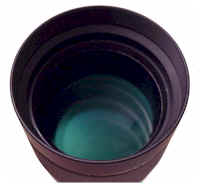 Simmons uses multi-coated lenses, which cuts down on reflection, loss of contrast and protects the soft optical glass beneath the coating. The aspherical lens system is suppose to provide an edge to edge flat image with uniform illumination and an extremely wide field of view. When I compared the AETEC with higher priced brands, it gave up nothing in “field of view” specs. Another one on the plus side, the green cast on the objective and ocular lenses goes well with the dark blue finish of the Winchester, a stylish combination that impressed the heck out of me.
Simmons uses multi-coated lenses, which cuts down on reflection, loss of contrast and protects the soft optical glass beneath the coating. The aspherical lens system is suppose to provide an edge to edge flat image with uniform illumination and an extremely wide field of view. When I compared the AETEC with higher priced brands, it gave up nothing in “field of view” specs. Another one on the plus side, the green cast on the objective and ocular lenses goes well with the dark blue finish of the Winchester, a stylish combination that impressed the heck out of me.
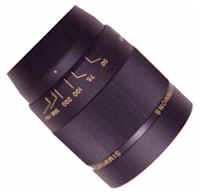 On the business end of the scope and one of the most important features of the AETEC 3.8-12X44, the Objective lens is adjustable for parallax correction. If you move your aiming eye off center of the ocular lens, and the reticle appears to shift relative to the distant target, there is parallax error. Parallax error exists when the target image in the scope and the reticle are on two different focal planes.
On the business end of the scope and one of the most important features of the AETEC 3.8-12X44, the Objective lens is adjustable for parallax correction. If you move your aiming eye off center of the ocular lens, and the reticle appears to shift relative to the distant target, there is parallax error. Parallax error exists when the target image in the scope and the reticle are on two different focal planes.
If you have a scope with AO – adjustable objective – you can crank the error out and get an optimally focused image. You can also keep your eye reasonably centered in the ocular lens and achieve the same result. The AETEC’s numbered index does look impressive, and it will be days before I get tired of playing with the adjustment, preset it to 150 yards and forget it’s even there. Young children, and new shooters will continue to be impressed by this feature for years to come.
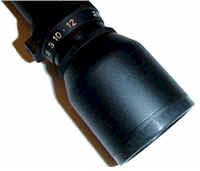 Focus and magnification controls are traditionally placed and very smooth in use. Some of my scopes seem to require a pipe wrench to make small adjustments, not the case with the Simmons, however that’s not suggesting controls are loose enough to unintentionally shift.
Focus and magnification controls are traditionally placed and very smooth in use. Some of my scopes seem to require a pipe wrench to make small adjustments, not the case with the Simmons, however that’s not suggesting controls are loose enough to unintentionally shift.
The AETEC has a very sharp image, clean colors, and excellent contrast. Overall, the fit and finish of the scope is very good, and I’d be hard pressed to find anything that would substantiate a basis for the low selling price – it doesn’t look cheap.
Installing a 30 pound scope on a 5 pound rifle
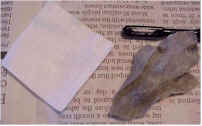 My first step in preparation of mounting the scope was to accomplish a task I hate, cleaning a new gun. Don’t know where the crud comes from, probably don’t care, but piles of black, orange and gray patches reaffirmed it’s not a good idea to shoot a new gun before it is thoroughly cleaned.
My first step in preparation of mounting the scope was to accomplish a task I hate, cleaning a new gun. Don’t know where the crud comes from, probably don’t care, but piles of black, orange and gray patches reaffirmed it’s not a good idea to shoot a new gun before it is thoroughly cleaned.
The bolt was pulled and the gun cleaned from the breech end. You can see from the before and after patches how bad the bore was, the next 20 patches pulled through looked about the same. The magazine well was loaded with preservative, as was the bolt and trigger assembly. After cleaning, contact parts were wiped with a light gun oil. I feel compelled to note that I wish manufacturers would stop putting those giant blob investment casting trigger guards on otherwise great looking rifles. Orange peeled Black paint is not a finish to associate with a firearm.
 The four plug screws on top of the receiver were removed to make way for the two piece scope base.The area on top of the receiver that would be under the scope base was wiped with Gun Scrubber to remove the oil film. The screw holes were lightly oiled to accommodate Torx fasteners. As you can see, I haven’t quite decided if the parts of a two piece base set are singular or plural.
The four plug screws on top of the receiver were removed to make way for the two piece scope base.The area on top of the receiver that would be under the scope base was wiped with Gun Scrubber to remove the oil film. The screw holes were lightly oiled to accommodate Torx fasteners. As you can see, I haven’t quite decided if the parts of a two piece base set are singular or plural.
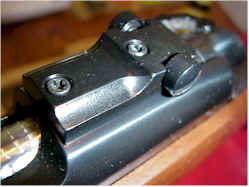 I used a Leupold part number 50022 two piece base. The rear mount includes a course windage adjustment that really helps to keep the scope internal adjustments closer to optical center. The mount adjustment is used to center the scope to the bore centerline during initial bore sighting. This leaves the scope’s internal adjustments at the center point of their range, which makes the full internal range of adjustment available for final sighting in. Both front and rear mounts can be swapped end for end to adjust for both scope tube and receiver length.
I used a Leupold part number 50022 two piece base. The rear mount includes a course windage adjustment that really helps to keep the scope internal adjustments closer to optical center. The mount adjustment is used to center the scope to the bore centerline during initial bore sighting. This leaves the scope’s internal adjustments at the center point of their range, which makes the full internal range of adjustment available for final sighting in. Both front and rear mounts can be swapped end for end to adjust for both scope tube and receiver length.
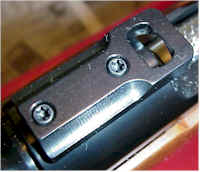 The front base was installed with the ring dovetail slot toward the rear. This set the optimal distance between rings for the scope, without interfering with cartridge feed or extraction. If the front base is fixed and the rear is adjustable, does that mean adjusting the rear base bends the scope tube ?
The front base was installed with the ring dovetail slot toward the rear. This set the optimal distance between rings for the scope, without interfering with cartridge feed or extraction. If the front base is fixed and the rear is adjustable, does that mean adjusting the rear base bends the scope tube ?
Torx fasteners won’t strip and are supposed to be used without Loc-Tite or similar thread treatment. Unfortunately, 5 or 6 rounds through my Weatherby and I have to start looking around on the ground for all the Torx fasteners. I use Loc-Tite.
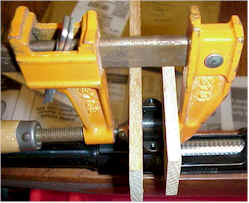 After quickly working my way through three $9 Leupold fiber filled plastic ring wrenches, I decided I needed something a little more durable. What you see is a front ring clamped between two short pieces of oak flooring.
After quickly working my way through three $9 Leupold fiber filled plastic ring wrenches, I decided I needed something a little more durable. What you see is a front ring clamped between two short pieces of oak flooring.
The long clamp provides a lot of leverage for adjustment, and when the ring is properly centered the clamp points straight down the barrel centerline. The oak cushions the rings and keep them straight, so they are never marred or tweaked. Hmm…maybe I can them in shrink wrap, “Clamp-O-Board” only $395.00.
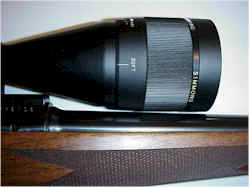 I used medium height Leupold matte finish rings, PN 49901. They are .770″ high, just enough for the scope to clear the mount and the barrel. There is actually .110″ between the front mount and the bell, and .045″ between the bell and the barrel with the scope correctly positioned for eye relief. I could have gone another .250″ higher, but it is always best to keep the scope as close as possible to the bore center line and the trajectory of the bullet.
I used medium height Leupold matte finish rings, PN 49901. They are .770″ high, just enough for the scope to clear the mount and the barrel. There is actually .110″ between the front mount and the bell, and .045″ between the bell and the barrel with the scope correctly positioned for eye relief. I could have gone another .250″ higher, but it is always best to keep the scope as close as possible to the bore center line and the trajectory of the bullet.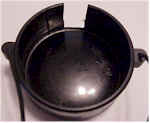
I cut a small notch in the lower portion of the front lens cap to facilitate installation and removal with the low scope mounting. The cap still rolls over and completely covers the lens and will definitely keep small animals and fingers off the optics. Overall the installation was clean and I think the scope looks pretty good on the Winchester.
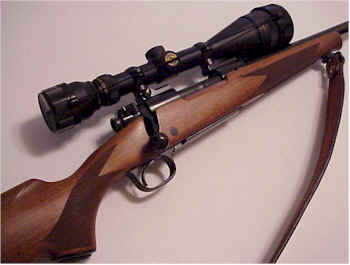 I’ll do a final set up with a Simmons Bore Sighter and drag the rifle up to the range and see how the combination shoots. I hope to have time to chronograph some loads and see what sort of impact the short barrel has on muzzle velocity and accuracy.
I’ll do a final set up with a Simmons Bore Sighter and drag the rifle up to the range and see how the combination shoots. I hope to have time to chronograph some loads and see what sort of impact the short barrel has on muzzle velocity and accuracy.
While I’m working on targets, I don’t believe the scope is an overkill. The gun still feels balanced, the scope is light, as is the overall package. In the mean time, I’ll continue my search for that more correct 2.5-6X 12 ounce scope.
More “Looking for a great small gun”
Looking for a great small gun
Looking for a great small gun II
Winchester Model 70 Scope selection / installation
A gripping story to catch you off guard
Handload Data 243 Winchester
Thanks,
Joe

Email Notification